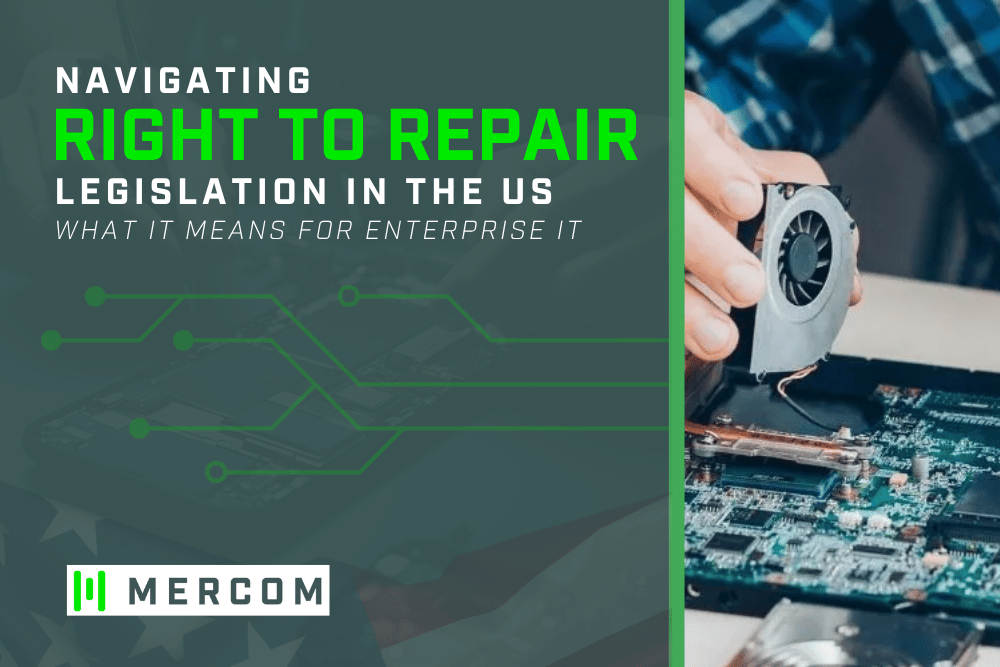Pros and Cons of 'Right to Repair' for IT Hardware
April 21, 2022

The right to repair sensitive equipment has long been a complex issue with compelling arguments on both sides.
The pros and cons of right to repair (RTR) laws often focus on cost and safety. Original equipment manufacturers (OEMs) are generally against the right to repair legislation. Consumer groups, however, have long been advocates, citing costs and control.
What Is Right to Repair?
Right to repair dictates that customers, whether individuals or corporations, should have the right to bring items for repair to any repair facility. You should also have the right to repair an item yourself.
This premise is common with many older technologies, including older cars and household appliances. However, modern electronics in cars, phones, laptops, and barcode equipment have complicated the issue.
Americans today are already allowed to repair whatever they buy. Even those stickers that note that unauthorized repairs void warranties are largely unenforceable.
Pros of RTR Legislation
Advocates of RTR legislation argue that current restrictions force customers to pay more for repairs. That’s because OEM manufacturers mandate using an authorized repair shop, especially for IT hardware.
In many cases, customers choose to replace devices, often unnecessarily, rather than use an approved repair shop.
OEMs make it very difficult to make repairs. Their tricks include using proprietary screws, gluing parts together and failing to publish repair documentation. These expensive measures make it difficult, if not impossible, for owners to repair devices where they want.
Many OEMs use other means to block unauthorized repairs. For example, some equipment can detect if unauthorized repairs are made, voiding warranties.
Advocates argue that right to repair laws should address several key issues, including:
- Making Information Accessible. Repair depots need manuals, schematics, instructions and software update datasheets. Software licenses should not restrict options to repair equipment and should be explicit about what is included
- Parts and Tools Availability. Parts and tools needed for diagnostics and repairs should be available to third parties and individuals
- Repair-Friendly Design. Equipment design should make it easy to access common systems and parts to facilitate repairs
- Allowing Unlocking. Owners should have the capability to unlock, modify or adapt a device to install custom software
Advocates argue that device and equipment owners must pay for expensive repairs without much choice. In addition, OEMs plan for forced obsolescence, where they discontinue support for older versions of devices. This practice forces owners to buy newer, more expensive versions rather than repairing and upgrading older models.
Cons for RTR Legislation
However, manufacturers argue that modern machines and equipment are too complex for third party repair companies . And no one argues that properly functioning machines result in better performance.
The issue for many OEMs is that the software coding and complex designs can be damaged if not correctly repaired. Improperly repaired machines can malfunction and cause harm to users or products.
OEMs argue that poor repairs can also expose products to increased security risks. Once those security measures weaken, hackers can more easily exploit technologies and cause extensive harm to equipment and systems.
OEMs say that restricting repairs to themselves is a form of quality control. Repair depots that do not use parts of a certain quality or perform repairs poorly are a significant risk. These repairs can weaken the OEM’s brand and reputation. It’s why so many OEMs advocate that unauthorized repairs should void warranties.
OEMs also argue that the software in equipment takes extensive time and money to create. The code driving these technologies is proprietary information. Preventing unauthorized repair shops from accessing this information protects their R&D investment.
Apple Decision Seen as Major Shift
In late 2021, Apple announced a marked change in its stance on the right to repair. The company had lobbied hard against legislation that freed up repair access for years. It did not provide access to documentation or tools that allowed consumers or independent shops to exact repairs.
However, the company announced it would offer parts, tools and manuals to individual owners of two of its newer products, the iPhone 12 and iPhone 13, beginning in 2022. Users could use the tools and parts to repair cameras, batteries, and displays at first, with additional repairs opened up later in the year.
The options come with caveats. The company noted that only individual technicians should use the new options and that most owners should still use repair shops.
Where Are We Today?
The White House, Congress, and the Federal Trade Commission have all weighed in recently regarding the right to repair issues.
President Joe Biden addressed the issue in a July 2021 executive order on consumer protections. The order encouraged the FTC to prevent OEMs from stopping individuals and independent repair shops from conducting repairs. That same month, the FTC voted to approve a policy statement enforcing stricter measures against practices that made it more difficult for consumers or smaller repair shops to repair products.
That report followed a May 2021 FTC report that examined OEM objections to right to repair laws. The agency found “scant evidence to support manufacturers’ justifications for repair restrictions.” The report, however, did leave room for the intellectual property and copyright issues OEMs face.
In February 2022, a bipartisan coalition introduced the Senate Fair Repair Act. The bill mirrors legislation filed in June 2021 in the House.
The Fair Repair Act would make repair documentation, parts and tools available to independent repair shops and consumers. The language in both versions is similar.
The Fair Repair Act also allows for easily resetting the hardware locks common in consumer electronics. By allowing for more refurbished devices, the legislation reduces e-waste.
The landscape for the right to repair changes rapidly. At Mercom, we offer hardware repair and certified refurbished equipment. To learn more about our services, contact us today.




